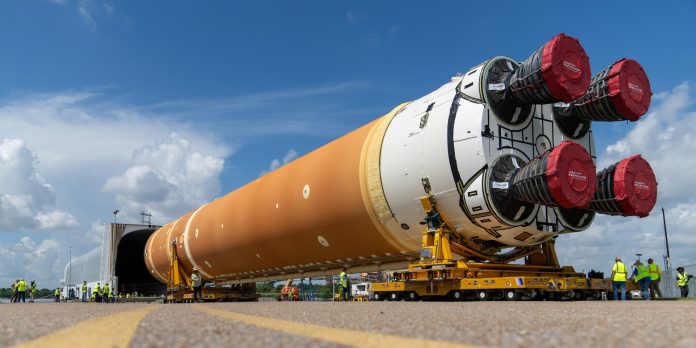NEW ORLEANS — NASA took another small step Tuesday on the anniversary of the historic launch to a giant leap.
Technicians moved the Space Launch System rocket core stage from inside the Michoud Assembly Facility on the 55th anniversary of the launch of Apollo 11 on July 16, 1969.
Tuesday’s move of the rocket stage for Artemis marks the first time since the Apollo Program that a fully assembled moon rocket stage for a crewed mission rolled out from Michoud. The rollout was from the manufacturing facility in New Orleans to ship the rocket to the Kennedy Space Center.
“With Artemis, we’ve set our sights on doing something big and incredibly complex that will inspire a new generation, advance our scientific endeavors, and move U.S. competitiveness forward,” said Catherine Koerner, associate administrator for NASA’s Exploration Systems Development Mission Directorate at NASA Headquarters in Washington. “The SLS rocket is a key component of our efforts to develop a long-term presence at the moon.”
Using highly specialized transporters, engineers maneuvered the giant core stage from inside the facility to the agency’s Pegasus barge. The barge will ferry the stage more than 900 miles to the Kennedy Center, where engineers will prepare it in the Vehicle Assembly Building for attachment to other rocket and Orion spacecraft elements.
“The delivery of the SLS core stage for Artemis II to Kennedy Space Center signals a shift from manufacturing to launch readiness as teams continue to make progress on hardware for all major elements for future SLS rockets,” said John Honeycutt, SLS program manager at the Marshall Space Flight Center. “We are motivated by the success of Artemis I and focused on working toward the first crewed flight under Artemis.”
The SLS rocket’s core stage is the largest NASA has ever produced. At 212 feet tall, it consists of five major elements, including two huge propellant tanks that collectively hold more than 733,000 gallons of super-chilled liquid propellant to feed four RS-25 engines.
During launch and flight, the stage will operate for just over eight minutes, producing more than 2 million pounds of thrust to propel four astronauts inside NASA’s Orion spacecraft toward the moon.
Don’t miss out! Subscribe to our email newsletter to have all our smart stories delivered to your inbox.



